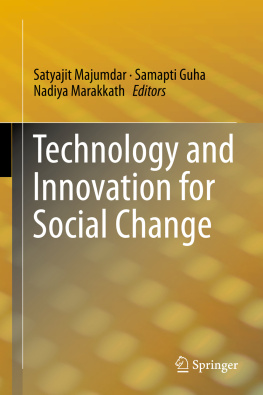1. Technology and Innovation for Social Change: An Introduction
Tension exists between technologists and social thinkers because of the impact technology and innovation has on social values and the norms which are often viewed as damaging the cultural fabric of a nation or society. Global business environment being the context in which implementation of technology and innovation takes place is widely accepted as the major reason for such conflicts. The current debate in India for and against the globalised and liberalised economic policies is the best case to cite. Social values and norms are the dynamic constructs of economic development and social entrepreneurs are the actors to drive such changes. Though the outlook of economic development is expected to be modern and contemporary, it should also address all-round growth and well-being in the society. Growth is expected to be inclusive in nature, without any bias towards particular socio-economic groups. However, data on the development and growth trajectories of many developing countries reveal undue favours to some specific groups, which have resulted into some kind of divide. The divide between rich and poor, rural and urban, educated and uneducated, upper and lower castes, indigenous and modern societies and technologically forward and backward societies are common in these countries. At times, high cost of technological innovation, access and ease of adoption of technologies are considered to be the chief reasons for such non-inclusion. Information Technology being the most adopted and accepted technologies is at the core of this debate which on other hand has also affected the major changes in social and political systems in many countries in the recent past. Also many other product and process technologies have affected favourably or otherwise the skill, livelihood and social norms in specific regions. This almost necessitates a fresh discourse, beyond anti-globalisation debates and bottom-of-pyramid market phenomenon. This Volume is one such first attempt to identify the relevant areas of new search, and research into them without labelling the social entrepreneurs - the social change agents, as heroic figures. In developing countries, social entrepreneurs have already established innovative and inclusive methods and systems such as micro-finance to impact social change. They are trained within the existing institutional set-up to practice social entrepreneurship processes; innovative educational models are also developed for such focused training. These social entrepreneurs design systems and processes for high social impact while adapting in countries, societies or communities, and adjusting to the specific local cultural norms or traditions or vocations. In this Volume, an attempt has been made to compile many independent research cases by the authors from across the globe. India, Mexico, Ethiopia, Nigeria, Thailand, Cambodia, Laos, Vietnam and other African countries are selected as contexts to report on multiple aspects of social change.
The snippet of the research discussed in this Volume which has themes at the interface of technology and social change is presented in this Chapter.
The first theme of the book discusses the concepts of social innovation and critical analysis . It begins with a paper by Nia Choi and Satyajit Majumdar, in which the authors formulated a model that can be used to analyse the existing social innovations. This Model is expected to enable readers to analyse an existing social innovation with regard to its formalised characteristics, actual changes in practice, and social structure that it induces and the social value that it effectively creates. With this analytical clarity at the backdrop, the next work by Samapti Guha and Nadiya Marakkath presents before the readers a case-based research, where the social innovation of microfinance is analysed with respect to two popular Indian models which are welfarist and minimalist in nature. Interesting variation in these Models is elucidated, based on which the need for design of demand-driven and client-centric social innovation models is called for.
Having discussed the relevance of such client-centric social innovative models, the second theme of the Volume discusses the role of institutional systems . Here, the work by Jos G. Vargas-Hernndez, and Mnica Isabel Garca Mora gains relevance as in their research they argued that despite the nature of institutional innovation, the larger institutional dynamics in which it operates, comprising of stakeholders, is to play a vital role for the perceived change to materialize in the society. Political parties, businesses, families, universities, non-governmental organizations (NGOs) and civil organizations are portrayed as the key institutional players that contribute to the developmental potential of any social change initiative in a region. Notwithstanding this organizational dynamics and stakeholder analysis, an empirical research by Evans S. Osabuohien and Uchenna R. Efobi found that for institutional systems like technology to reap intended benefits in places like Africa, human capital development and resultant economic development should be an important predecessor. Therefore, they suggested improvements in educational system, as it will play a crucial role in human capital development. They argued that it will help to drive the essential technical know-how as well as assist in reduction of information asymmetry. Knowledge will be better transmitted when there is functional knowledge system in a society. In this context, a case research by Yaso Thiru, Satyajit Majumdar and Samapti Guha refers to how in India, an innovation in education model, created a cadre of graduates in social entrepreneurship, instrumental in filling the gap left by the withdrawal of states from supporting social programmes and the failure of markets, to meet the needs of rural and urban India and marginalized communities. Thus, the power of education in social change is articulated by the authors by presenting the case of an innovative education model at the Tata Institute of Social Sciences, Mumbai, India.
Imbibing the learnings from this case, the next theme focuses on transformation which is seen in the society. The research by Archana Singh and Satyajit Majumdar portrays before the readers as to how technology and innovation play a transformational role in facilitating the individuals social change process or how individuals deploy technology and use innovation to create social change. The chapter by Bharat Damani, Vishal Sardeshpande and A. W. Date adds to this discussion by stating that the best approach to social change would be to focus on the change that is intended, and then find innovative solutions which could use technology in an appropriate manner as against the conventional approach wherein technology and innovation are positioned as the initiators and drivers of social change. Gladys Idogo strengthens this observation by stating that sometimes what would be termed as innovation in places like Africa could be something simple as a technology-enabled communication system as this can strengthen information exchange among their families, the strongest pillar of any society.
Thus, after setting stage to understand what technology can mean to social change, three case studies are presented in the last theme of the Volume by Madhulika Kumari and Sambit Mallick, Smriti Saraswat, and Upasana Ray and Asoka Kumar Sen, respectively. These cases show that though society does not silently accept technologically enforced changes, sometimes technology is seen as a villain of inclusive growth, and for many, economic development is an anti-thesis of social change. The select cases on sector-specific technologies, such as genetically modified seeds in agriculture which has impacted the market and society, are critically analysed to develop insights on technology adoption and resultant impact while examining the policy-related issues, without any bias in favour or against a specific technology.









